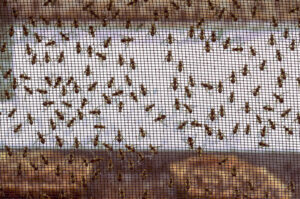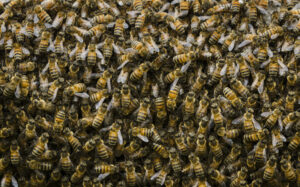
Insects as livestock
By Denis Crawford
There is a long and fascinating history of mass rearing of various insects, and it seems that the practice is set to expand somewhat.
There has been a lot of press in the last couple of years about farming insects for human consumption. You might think that insects have been mass reared in this way for centuries, but rearing insects for human consumption is a relatively recent thing. Insects have been foraged for food for millennia but not seriously farmed as human food.
Insect-eating has been part of human culture for a long time. There is evidence that early hominids in southern Africa were using bones as tools to extract termites from their nests about one million years ago. Insect consumption is a recent and novel phenomenon in the US and Europe, but insects were traditionally part of human diets in many countries in Africa, Asia, Latin America and Oceania.
It is claimed that today over two billion people eat insects weekly worldwide. More than 1,500 insect species have been documented in literature as edible, mostly from tropical countries. Commonly eaten insect groups include beetles, caterpillars, bees, wasps, ants, grasshoppers, locusts, crickets, cicadas, leafhoppers, scale insects, bugs, termites, dragonflies, and flies.
Why this sudden interest in farming insects for human consumption? The UN says that by 2050 the world will host 9 billion people and that current food production will need to expand by about 60 percent. The nutritional value of insects compares very favourably with that of meat and fish, for example insects contain a high amount of crude protein.

Rearing insects has distinct advantages over rearing other (much larger) livestock such as cattle and sheep. For example, insects can convert their feed into increased body mass way more efficiently than large livestock, and insects emit few greenhouse gases. Rearing insects requires significantly less water than rearing cattle and sheep, and insect rearing facilities require much less land than traditional farms.
Thailand is one of the few countries in the world to have a reasonably large insect farming industry. Although they are mostly small-scale home-based operations there are more than 20,000 of them. Insect farming has really only taken off in the last couple of decades driven by strong market demand. We have probably all seen images from Thai markets of baskets piled high with crickets and scorpions et cetera.
In the West, eating insects used to be seen as a thing only done in ‘poor’ countries, but that has changed a little since the introduction of insects in novel snack foods. Chocolate ant anyone? Insect farming is expanding though, and currently there are operations in Thailand, France, South Africa, China, Canada, and the United States. Where it goes who knows? Insects mass reared for consumption by other animals (such as pigs, poultry, and fish) might be a more palatable option for us squeamish Westerners.
Insects have been bred for thousands of years for several other reasons than eating them. For example, humans have been keeping honey bees (Apis mellifera) in hives for at least 5,000 years. Today in Australia, it is estimated that the European honey bee contributes about $4-6 billion per annum in agricultural production (in crops that respond to bee pollination).

Mass rearing of silk moths (Bombyx mori) for the production of raw silk, has been under way for about 5,000 years in China. Today, although at least 22 countries produce some amount of silk, China accounts for about 80% of the global production of 202,000 metric tonnes per year.
The cochineal insect (Dactylopius coccus) has been harvested for its bright red (carmine) pigment, in Central America, for about 2,000 years. The industry is now dominated by Peru (80% of global share) where they have been producing cochineal dyes for textiles for at least a thousand years.
There is a fascinating Australian connection with the cochineal industry. The cochineal insect feeds on cacti of the Opuntia genus. Cochineal infested plants were brought to Australia with the First Fleet in 1788 in an attempt to start a cochineal dye industry. The cochineal industry was monopolised by Spain and Portugal at the time, and the British Empire wanted its own sources.
Unfortunately, the insects died but the plants (Prickly Pear) survived and spread wildly, eventually infesting about 250,000 km2 of NSW and Queensland. Prickly pear was brought under control by the introduction and mass rearing of the South American moth Cactoblastis cactorum. The black and orange striped larvae of the moth feed on the cactus. The moth, and cochineal insects, keep prickly pear and other cacti in the Opuntia genus under control to this day.
The above example of classic biological control leads us to the sterile insect technique (SIT) where huge numbers of sterile insects are released into the wild. In Australia, the control of Queensland fruit fly and Mediterranean fruit fly are good examples. This is mass rearing of insects on an industrial scale – the flies are reared in their millions and sterilised using gamma or x-rays. The sterile males mate with wild females which results in infertile eggs being laid. SIT is used in other countries to control pests such as screw-worm fly (Cochliomyia hominivorax) and Tsetse fly (Glossina spp.).
In previous Pest Files I have detailed the beneficial insects that are available commercially for the control of various horticultural pests. These insects are mass reared so they can be released into crops that are under pest pressure. The best place to start with commercially available good bugs is www.goodbugs.org.au. Biological control is but one part of any IPM strategy and is not a “quick fix” option. That’s a good thing because it was “quick fixes” which got us to where we are now – with many pesticide-resistant pests, and reduced biodiversity.
Main photo: Tiny Trichogramma wasps are mass reared to control caterpillar pests (image supplied by Denis Crawford)
